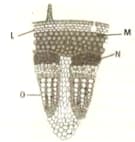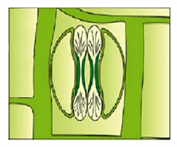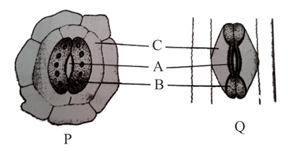Parenchyma, collenchyma, and sclerenchyma are cells of vascular tissue.
Important Questions on Organisation in Living Things
II. It is a couple of layer thick.
III. It is made up of thin-walled rectangular cells.
Select the incorrect statements.
From the following options, choose the false one regarding the statements given with respect to the diagram.

(i) 'L' is the collenchymatous hypodermis that provides mechanical strength and flexibility to young dicot stems.
(ii) 'M' is the innermost layer of the cortex which usually possesses Casparian strips.
(iii) 'N' is the parenchymatous pericycle that synthesizes food.
(iv) 'O' is xylem which is exarch with respect to the positions of protoxylem and metaxylem.

(i) Grass
(ii) Tomato
(iii) Banana
(iv) Brinjal
(v) Soybean
(vi) Lily
(i) Lateral roots develop from pericycle.
(ii) Endodermis is the innermost layer of cortex.
(iii) Sapwood is the central, dark-coloured, non-conducting part of secondary xylem.
Reason : Casparian strips in endodermis are suberized.
Given figures (P and Q) represent the stomatal apparatus of dicot and monocot leaves respectively. Select the option which correctly labels A, B, and C.

Statement 1 Anatomically, all the tissues present on the inner side of endodermis such as pericycle, vascular bundles and pith constitute the stele.
Statement 2 Eustele is the stele in which vascular bundles are arranged in the form of a ring as present in dicot stems.
Represent the union of two sets by Venn diagram for each of the following.
is a prime number between and
is an odd number between and

